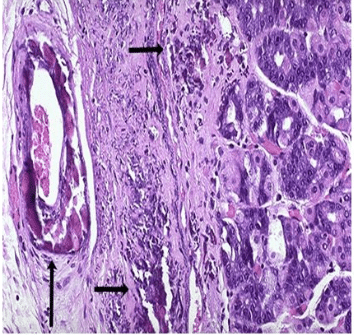Pathological Calcification
Pathological calcification

calcification in stomach
is an abnormal deposition of calcium salts in the body tissues along with smaller amounts of minerals like iron, magnesium and a few others.
Classification of Pathological Calcification
It is classified as dystrophic calcification & metastatic Calcification.
Dystrophic Calcification
Dystrophic calcification is macroscopic deposition of Ca salts in dead, degenerated or injured tissue. The metabolism of calcium remains normal during this type of calcium and does not affect the normal calcium metabolisms of the body. Dystrophic calcification is initiated by the extracellular deposition of crystalline calcium phosphate in the membrane-bound vesicles. As it represents extracellular deposition of calcium from circulation, therefore it can be seen by a naked eye.
WATCH WORLD’S BEST VIDEO LECTURE ON THIS TOPIC (SIGNUP REQUIRED)
Causes of Dystrophic Calcification
There are several factors that can cause dystrophic calcification and they include organ dysfunction, damaged heart valves, compromised valve motion and Aortic heart valves.
Examples include caseous necrosis in tuberculosis is the most common site and has no functional consequences. Dystrophic calcification may also occur in mitral or aortic valves. It can lead to impeded blood flow because it produces inflexible valve leaflets and narrowed valve orifices (mitral and aortic stenosis).
WATCH WORLD’S BEST VIDEO LECTURE ON THIS TOPIC (SIGNUP REQUIRED)
Metastatic Calcification
Metastatic calcification is a result of the change in serum Ca level because of an abnormality. It disturbs the calcium concentration greatly and therefore causes the deposition of calcium into the body tissues and organs.
Causes of Metastatic Calcification includes increased secretion of parathyroid hormone, destruction of bone tissue as in tumors of bone marrow, Vit. D related causes – Vit D intoxication & renal failure.
Other Forms of Calcification
Formation of stones containing calcium carbonate in sites such as gallbladder, renal pelvis, and pancreatic duct. Under certain conditions, the mineral salts precipitate from solution and crystallize around foci of organic material.
Presence of calcification on or under the skin. There are two forms of calcinosis.
Calcinosis circumscripta, as the name, suggests it’s a circumscribed form, thus causing calcification.
Calcinosis universalis often associated with scleroderma and sometimes dermatomytosis. because it is called calcinosis. therefore it is calcinosis universalis. Thus we can call it calcinosis.
WATCH WORLD’S BEST VIDEO LECTURE ON THIS TOPIC (SIGNUP REQUIRED)
Disclaimer: The information provided on this website (www.MadeForMedical.com) is only for educational purpose. While we tried hard to write quality articles but still, the articles and the information within them is not guaranteed to be free of factual errors or typos and hence may not be correct. You are advised to independently verify the claims in the articles and make your own conclusion.
